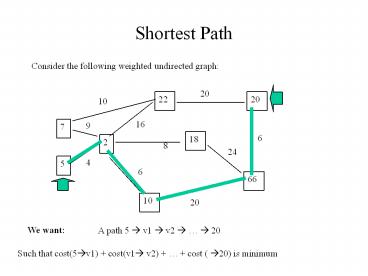Shortest Path - PowerPoint PPT Presentation
Title:
Shortest Path
Description:
Change Dijkstra's Algorithm (Slide 6) to compute the minimum distance from u to ... of 2.b (Page 323). Follow Dijkstra's Algorithm to compute the path from l ... – PowerPoint PPT presentation
Number of Views:1273
Avg rating:3.0/5.0
Title: Shortest Path
1
Shortest Path
Consider the following weighted undirected graph
20
22
20
10
16
9
7
6
18
2
8
24
4
5
6
66
10
20
Such that cost(5?v1) cost(v1? v2) cost (
?20) is minimum
2
How About Using the MST Algorithm?
20
22
20
10
16
9
7
6
18
2
8
24
4
5
6
66
10
20
- Compute the MST
- Take the path between the two nodes that goes
through the MST
3
The Fringe
Given a Graph G (V,E) and T a subset of V, the
fringe of T, is defined as Fringe(T)
(w,x) in E w ? T and x ?V - T
4
Djikstra Algorithm Idea
- We are computing a shortest path from node u to a
node v - Start the algorithm with T u, construct
Fringe(T) - At each iteration, select the (z,w) in Fringe(T)
such that the path from u to w has the lowest
cost - Stop when v is part of T (not of the fringe!)
5
Example
20
22
20
10
16
9
7
6
18
2
8
24
4
5
6
66
10
20
6
The Dijkstras Algorithm
// Input G (G,V), nodes u and v in V //output
Shortest path from u to v
T ? u F ? Fringe(u) ET ? While v is not
in the T do Choose (z,w) in F with the
shortest path (u, u1),
(u1,u2),, (un,z) (z,w) with (u, u1),
(u1,u2),, (un,z) in ET T ? T ? w
ET ? ET ? (z,w) for each (w,x)
(w,x) in E - ET do If no (w,x) in
F then F ? F ? (w,x) else
If the path u ? x going through (w,x) has less
weight than the path u?x going through
(w,x) then F ? ( F - (w,x)) ? (w,x)
7
Properties
Is Dijkstras Algorithm greedy?
Yes
Why Dijkstras Algorithm works?
8
Complexity
- Actual complexity is O(Elog2 E)
- It is easy to see that it is at most EV
(i.e., E2) - the outer while is performed V times
- the inner for is performed at most E times
9
Homework
- 010
- Write the pseudo-code for the algorithm inserting
an element in a min-heap - Do the same for a Heap
- Write the pseudo-code for isLeaf(i) (Slide 15 of
class about Heaps) - Change Dijkstras Algorithm (Slide 6) to compute
the minimum distance from u to every node in the
graph - True or False the subgraph (T,ET) resulting from
4 is an MST of the input graph - In the graph of 2.b (Page 323). Follow Dijkstras
Algorithm to compute the path from c to l - 011
- Write the pseudo-code for the algorithm deleting
the element with the minimum priority value in a
min-heap - Do the same but deleting the one with the highest
priority for a Heap - Write the pseudo-code for Parent(i) (Slide 15 of
class about Heaps) - Change Dijkstras Algorithm (Slide 6) to compute
the minimum distance from u to every node in the
graph - True or False the subgraph (T,ET) resulting from
4 is a tree connecting all nodes of the input
graph - In the graph of 2.b (Page 323). Follow Dijkstras
Algorithm to compute the path from l to a































